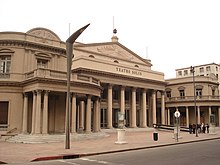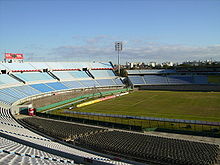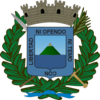Montevideo
This article needs additional citations for verification. (May 2008) |
Montevideo | |
|---|---|
| The Plaza Independencia, Independence Square. The Plaza Independencia, Independence Square. | |
|
| |
| Nickname: none | |
| Motto(s): Con libertad ni ofendo ni temo With liberty I offend not, I fear not. | |
 | |
| Coordinates: 34º 53'S 56º 10'W | |
| Country | Uruguay |
| Department | Montevideo Department |
| Founded | 1726 |
| Founded by | Bruno Mauricio de Zabala |
| Government | |
| • Municipal Intendent | Ricardo Ehrlich |
| Elevation | 43 m (141 ft) |
| Population (2004) | |
| • Total | 1,325,968 |
| • Rank | 1st |
| • Demonym | Montevideano |
| Time zone | UTC-3 |
| • Summer (DST) | UTC-2 (GMT -2 (DST)) |
| postal code | 10000 |
| Area code | +02 |
| Website | www.montevideo.gub.uy |
Montevideo (Spanish pronunciation: [monteβiˈðeo]) is the largest city, the capital and chief port of Uruguay. Montevideo is the only city in the country with a population over 1,000,000. According to Mercer Human Resource Consulting, Montevideo provides the highest quality of life in Latin America.[1][2][3] It is the seat of the Roman Catholic Archdiocese of Montevideo.
Geography
Montevideo is situated in the south of the country, The geographic coordinates are 34.5° S, 56°W.
18 de Julio is the city's main avenue and extends from the Plaza Independencia, which is the junction between the Ciudad Vieja (the historical quarter) and the rest of the city, to the boundary between the neighborhoods of Cordón and Parque Batlle.



History
Early history
The city's first economic boom occurred when the Spanish Crown gave Montevideo the right to be the only slave port in the Viceroyalty of la Plata, infuriating the Viceroyalty's capital, Buenos Aires.[citation needed] In 1776, the Crown further made Montevideo the main naval base (Real Apostadero de Marina) for the South Atlantic, with authority over the Argentine coast, Fernando Po, and the Falklands.[4]
In 1828, the town became the capital of Uruguay.[citation needed]
The city fell under heavy British influence from the early 19th century until the early 20th century as a way to circumvent Argentine and Brazilian commercial control. It was repeatedly besieged by Blanco leader Manuel Oribe and Argentine dictator Juan Manuel de Rosas between 1838 and 1851. Between 1878 and 1911, British-owned railway companies built an extensive railway network linking the city and its port to the countryside.
20th century

During World War II, a famous incident involving the German pocket battleship Admiral Graf Spee took place in Punta del Este, 200 kilometres (120 mi) from Montevideo. After the Battle of the River Plate with the Royal Navy and Royal New Zealand Navy on December 13, 1939, the Graf Spee retreated to Montevideo's port, which was considered neutral at the time. To avoid risking the crew in what he thought would be a losing battle, Captain Hans Langsdorff scuttled the ship on December 17. Langsdorff committed suicide two days later.
On 10 February 2006, the eagle figurehead of the Admiral Graf Spee was salvaged.[5] To protect the feelings of those still sensitive to Nazi Germany, the swastika on the figurehead was covered as it was pulled from the water.
Since 2005 the Mayor of Montevideo (styled Intendente Municipal in Spanish) has been Ricardo Ehrlich, of the Frente Amplio (Broad Front), gaining 61% of the vote in the Mayoral elections, beating Pedro Bordaberry of the Partido Colorado, who scored 27%.[citation needed]
Economy and demographics
Montevideo began as a minor settlement. In 1860, Montevideo had a population of 37,787.[citation needed] By 1884, the population had grown to 104,472, including many immigrants.[citation needed]
During the mid-20th century, a military dictatorship and economic stagnation caused a decline whose residual effects are still seen today. Many rural poor flooded the city, with a large concentration in Ciudad Vieja.[citation needed]
Transport
This section needs expansion. You can help by adding to it. (December 2008) |
Montevideo is served by Carrasco International Airport.

Neighborhoods

Montevideo, Pocitos Neighborhood
Education





- University of the Republic, Uruguay
- Stella Maris College (Montevideo)
- The British Schools of Montevideo
- ORT Uruguay
- Instituto Alfredo Vásquez Acevedo
- Instituto Preuniversitario JUAN XXIII
- Lycée Français
- Escuela Brasil (Montevideo)
- Liceo Joaquin Suarez (Montevideo)
- Saint Patrick's College
Culture
Montevideo has a very rich architectural heritage and an impressive number of writers, artists, and musicians. Uruguayan tango is a unique form of dance that originated in the neighborhoods of Montevideo towards the end of the 1800s. Tango, candombe and murga are the three main styles of music in this city.
Sports
Montevideo hosted all the matches of the 1st FIFA World Cup in 1930. Its Estadio Centenario is considered a major stadium. The city is home to five significant South American football clubs: Peñarol, Defensor Sporting,Danubio,Montevideo Wanderers and Nacional.
Sites of interest
- Centenario Stadium
- Salvo Palace
- Telecommunications Tower
- Solis Theatre
- Palacio Legislativo
- Catedral Metropolitana
- Cabildo de Montevideo
- Feria de Tristán Narvaja
- Monument to Sexual Diversity
Sister cities
 Barcelona, Spain
Barcelona, Spain Berlin, Germany
Berlin, Germany Bogotá, Colombia
Bogotá, Colombia Buenos Aires, Argentina
Buenos Aires, Argentina Cádiz, Spain
Cádiz, Spain Córdoba, Argentina
Córdoba, Argentina Curitiba, Brazil
Curitiba, Brazil Porto Alegre, Brazil
Porto Alegre, Brazil La Plata, Argentina
La Plata, Argentina Madrid, Spain
Madrid, Spain Melilla, Spain
Melilla, Spain Montevideo, United States
Montevideo, United States Qingdao, China
Qingdao, China Quebec City, Canada
Quebec City, Canada Rosario, Argentina
Rosario, Argentina Saint Petersburg, Russia[6]
Saint Petersburg, Russia[6] Tianjin, China
Tianjin, China Wellington, New Zealand
Wellington, New Zealand
Climate
Montevideo enjoys a subtropical climate with, mild and dry winters, hot and humid summers, agitated springs with numerous thunderstorms, and without Tropical cyclones.
| Climate data for Montevideo | |||||||||||||
|---|---|---|---|---|---|---|---|---|---|---|---|---|---|
| Month | Jan | Feb | Mar | Apr | May | Jun | Jul | Aug | Sep | Oct | Nov | Dec | Year |
| Source: Servicio de Oceanografía, Hidrografía y Meteorología de la Armada | |||||||||||||
References
- ^ See also La Nación, Chilean newspaper article that mentions the three Latin American cities with highest quality of life according to the MHRC 2007 investigation.
- ^ Montevideo, la mejor ciudad para vivir de América Latina (Montevideo, the best town to live in Latin America) at Uruguayan newspaper La República (April 3, 2007)Template:Es
- ^ Article from the Café Template:Es
- ^ Armada Nacional, 2008. http://www.armada.mil.uy/general/historia/historia-armada.html. Retrieved 4 October 2008.
- ^ "Graf Spee's eagle rises from deep". BBC News. February 10, 2006.
- ^ St. Petersburg in figures > International and Interregional Ties


